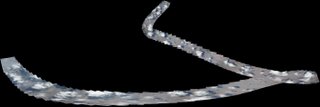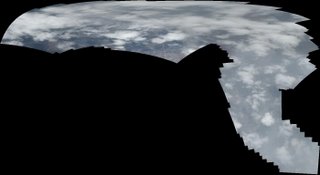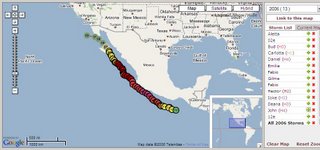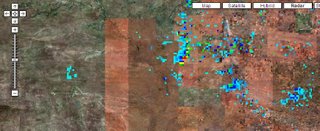Welcome Slashdot. For those of you who are interested in following up on what we are going to do with the data (google maps, Earth, video, high definition desktop background, torrents,...), our RSS feed is at http://hasp-geocam.blogspot.com/atom.xml
We will be responding and expand on the comments of the previous entry on panoramic views in the upcoming days.
Saturday, September 30, 2006
Being Slashdotted.
Posted by
Igor
at
11:13 AM
0
comments
![]()
![]()
Panoramic views
[Slashdot readers]
An interesting use of the data from GeoCam is to see how stitching algorithms are performing with data from our balloon flight. An algorithm developed by Matthew Brown does this automatically through the comparison of SIFT points and a RANSAC algorithm determining good fit. The software is available at the AutoStitch web page.
We first tried stitching five photos together and obtained a reduced file (200 KB as opposed to 5 times 3.2 MB)
We then went on using about 100-200 frames per panoramas and obtained the following views:
It seems evident that the payload wasn't turning at 1 rpm.



One of the apparent issues seems to be that the comparison for overlap between frames was based on cues from the clouds. Since we took photos at intervals of about 23 seconds, some of these clouds changed location and eventually allowed for some of the panoramas to be unduly stretched.
Posted by
Igor
at
4:16 AM
10
comments
![]()
![]()
Thursday, September 28, 2006
Panoramic views - Preliminary results
An interesting use of the data from GeoCam is to see how stitching algorithms are performing with data from our balloon flight. An algorithm developed by Matthew Brown does this automatically through the comparison of SIFT points and a RANSAC algorithm determining good fit. The software is available at the AutoStitch web page.
We first tried stitching five photos together and obtained a reduced file (200 KB as opposed to 5 times 3.2 MB)
We then went on using about 100-200 frames per panoramas and obtained the following views:
It seems evident that the payload wasn't turning at 1 rpm.



One of the apparent issues seems to be that the comparison for overlap between frames was based on cues from the clouds. Since we took photos at intervals of about 23 seconds, some of these clouds changed location and eventually allowed for some of the panoramas to be unduly stretched.
Posted by
Igor
at
2:46 AM
9
comments
![]()
![]()
Thursday, September 21, 2006
WOW

Pam and John opened the camera an hour ago and found 1650 images. This is mission success. Each image is about 3.7 MB. We are beginning to work on implementing an interface so that it can be browsable to the rest of the world. The image of this entry is one of these shots taken by GeoCam.
Posted by
Igor
at
12:58 PM
1 comments
![]()
![]()
Wednesday, September 20, 2006
NASA Balloon Carries High Altitude Student Platform to the Edge of Space
NASA just came out with a press release on the whole HASP program, take a look at it here.
After reading about this story on Slashdot, I noticed in the comment section that last year, some other team did something similar to our project but it looks like their camera froze on the way up. Our current expectation is that the camera might have gotten very warm once it reached 120,000 feet. We'll see when the payload arrives home. A related effort at NOAA is similarly interesting. We believe that the main difference between all these payloads and ours is our stated goal of making a mapping of these pictures onto real maps (google maps). Our camera was specifically focused to get the most detail out of the landscape whereas most of the helium balloon shots seem to have looked at the wider angle to get shots of "space".
Posted by
Igor
at
2:46 PM
0
comments
![]()
![]()
Tuesday, September 12, 2006
Coming home

The crates should have been picked up at Ft. Sumner today and we expect to see them at LSU later this week.
Posted by
Igor
at
8:07 AM
0
comments
![]()
![]()
Thursday, September 07, 2006
HASP recovery

The HASP payload, parachute and balloon have been recovered successfully. A brief damage assessment was undertaken and the experiment is going to be packed for shipment back to LSU, and then back to Texas A&M.
We are anxiously waiting for the arrival of GeoCam to evaluate how bad the cloud cover was.
Posted by
Igor
at
2:41 PM
0
comments
![]()
![]()
Tuesday, September 05, 2006
Fort Sumner, HASP has landed
The HASP flight ended at 9:19 UTC today with termination of the balloon. The payload parachuted down, slowing to a speed of about 20 feet / second and impacted at 112 deg 0.45 min W, 35 deg 47.0 min N at 10:02:20 UTC. This location is just a bit south of the Grand Canyon. Needless to say, this was an exciting balloon flight termination. In preparation for termination, the student payloads were turned off at 8:05 UTC. Thus, the HASP flight was 18 hours 12 minutes long and all payloads were at a float altitude of at least 111,800 feet for about 13.5 hours. We are expecting to get HASP back to Ft. Sumner within a couple of days.

Posted by
Igor
at
12:28 PM
0
comments
![]()
![]()
Monday, September 04, 2006
Launch and CosmoCam control
HASP was launched at 9:50 am (15:50 UTC) this morning. The payload is now climbing through 7000 meters. Watch CosmoCam for the release of the glider at about 30,000 feet. After that CosmoCam is available for use by anybody.
Posted by
Igor
at
2:42 PM
0
comments
![]()
![]()
Sunday, September 03, 2006
It's all your fault, John!

Greg Guzick tells us the following:
The weather just could not give us a break this morning, and a new line of rain storms are developing to the west of us and heading this way. Thus, we have canceled the launch attempt today and will try again tomorrow. In fact, tomorrow’s launch weather should be much, much better. The down side is that Tropical Storm John will be moving up the Baja coast and setting off thunderstorms in the Arizona southwest where HASP is predicted to impact following termination. Thus, with a launch tomorrow we may need to cut down early, resulting in only 10 hours at float.
The new launch target is Monday, September 4 at 7:30 am (13:30 UTC). Pre-launch ops will begin at 3:30 am and pickup will be at 4:00 am.
John is moving off the Baja coast.
Posted by
Igor
at
2:22 PM
0
comments
![]()
![]()
Saturday, September 02, 2006
Bad (weather today) is Good (for us tomorrow)

Here are the news from Greg Guzick:
The cold front that has brought some amazingly bad weather to the area today is expected to move further south during the day and evening resulting in improving conditions here. In addition, the high altitude winds continue to slow and current predictions are for about 16 hours at float. Thus, we will be attempting to launch HASP tomorrow morning. Activities will begin here at about 3:30 am Mountain time, targeting a launch time of about 7:30 am Mountain (13:30 UTC). As surface winds are expected to continue to decrease during this time period, launch could be delayed several hours.
CosmoCam will be running during most of the pre-launch period and there may be occasional audio commentary. Live views of the launch area from the tower can be obtained from the CSBF website.
Posted by
Igor
at
2:48 PM
0
comments
![]()
![]()
Friday, September 01, 2006
Tic toc tic toc
Here is the latest from Greg Guzick:
The weather brief today is still projecting good weather for Sunday (9/3) morning. In addition, the high altitude winds are starting to come down. Currently we are projecting 15 hours at float. A final decision to go for the Sunday launch will come after tomorrow’s weather brief.
Posted by
Igor
at
3:40 PM
0
comments
![]()
![]()

